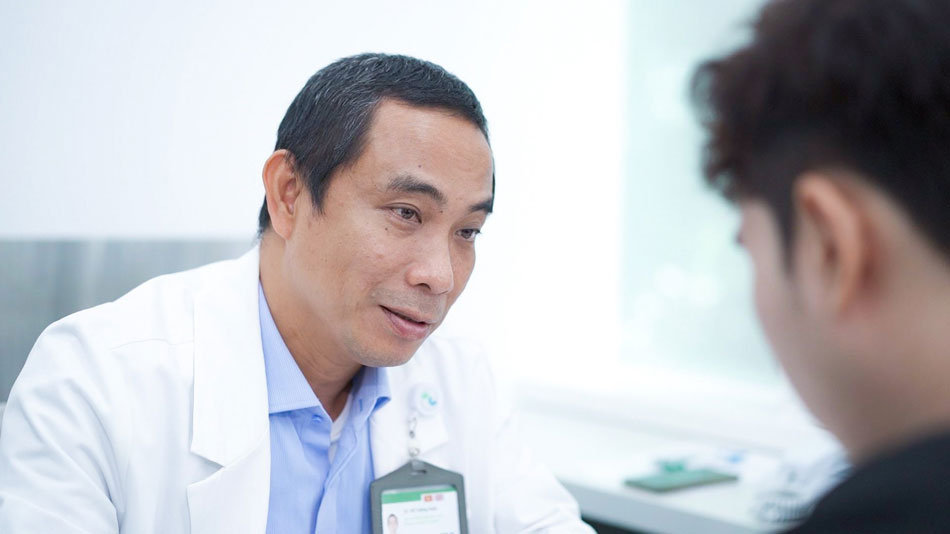Dr Do Tuong Huan, a head and neck cancer surgery specialist at FV Hospital, says that skin cancer in the head and neck area is quite common in Vietnam. This disease has a high chance of being cured when detected in its early stages. However, patients often neglect initial symptoms, resulting in late detection of the disease and making treatment more difficult.
Head and neck skin cancer treatment has a high success if cases are detected early
Dr Do Tuong Huan, a head and neck cancer surgery specialist at the Otorhinolaryngology (ORL or ENT) Department, FV Hospital, said that there are three common types of skin cancer: basal cell carcinoma, squamous cell carcinoma, and melanoma. The most common type of skin cancer in the head and neck area is basal cell carcinoma which is mainly caused by prolonged frequent exposure to sunlight.

Dr Do Tuong Huan advises patients on head and neck skin cancer
Areas that are directly exposed to sunlight for a long period of time and are damaged by UV rays are at the highest risk of cancer. “Initial symptoms may be the appearance of new moles, existing moles that show changes in size and colour or begin bleeding, or sores on the skin that do not heal. When these signs appear, patients should go to specialised medical facilities for examination and diagnosis,” adds Dr Huan.

Skin abnormalities can be a sign of skin cancer
Skin cancer in the head and neck area can typically be treated surgically when detected early. According to Dr Huan, in addition to removing cancerous cells, retaining function and aesthetics are important when treating head and neck cancer. When the disease is detected late, it tends to spread laterally and vertically, often extending deep into tissues, making any surgical procedure more complex. In some cases, the cancer may have spread to bone and other areas in the face, making the treatment process more difficult; the ability to retain aesthetics and function after removing larger tumours may not be as high as when the disease is diagnosed in its early stages.
Cryosurgery can remove all cancerous cells in the head and neck area
Dr Huan has over 20 years of experience in the field of head and neck cancer surgery during which he performed thousands of surgeries. He says that when treating skin cancer in the head and neck area, the surgical procedure must ensure that the edge of the tumour is completely removed, and no cancerous cells remain.
To achieve this, doctors at FV Hospital examine the cutting surface in the operating room to see if any cancer cells remain using a rapid tissue processing technique via cryostat machine.
“Usually, when we remove the tumour mass, the surgical team will cut cross sections of and send them to the pathology department for technicians to process before a doctor reviews the results, which can take a few days. If cancer cells are still present in the body after surgery, a second operation is required. However, using the cryostat technique, pathologists can process and provide results for that tissue sample within 30 minutes, allowing the surgeon to know immediately if they have removed all of the cancer cells. This leads to better treatment outcomes and reduces the risk of recurrence,” explains Dr Huan.

The cryo-cutting technique provides tissue sample test results within 30 minutes
The strength of FV Hospital in the treatment of head and neck skin cancer lies in its team of multi-disciplinary specialist doctors, each of whom is skilled in diagnosis and treatment. Oncologists collaborate with the Anatomopathology Department, a part of the Laboratory & Blood Bank Department at FV Hospital. This specialist department is equipped with modern facilities and the latest advanced technology, including machines that return accurate results quickly from frozen sections, helping to shorten the time needed for diagnosis and treatment.
To prevent skin cancer in the head and neck area, Dr Do Tuong Huan recommends that people avoid direct and prolonged exposure to harsh sunlight by using protective items such as wide-brimmed hats, scarves, or sunscreen. In addition, people should pay attention to any lumps in the skin, sores that don’t heal, skin lesions resembling new moles, or moles that have been present for a long time but have changed in size and colour or are bleeding, and seek immediate medical attention when any of these symptoms occur.
“When an experienced team detects and treats cancer early with advanced techniques, this can drastically increase the likelihood of removing all cancer cells and improving the patient’s quality of life,” says Dr Huan.
Dr Do Tuong Huan decided to partner with FV Hospital to provide patients with the best treatment experience in an internationally accredited environment. Dr Huan will leverage his talent and experience to contribute to developing the Otorhinolaryngology (ORL or ENT) Department into a sought-after medical facility for patients in Vietnam and overseas who require care for head and neck tumours.
To make an appointment with Dr Do Tuong Huan, Otorhinolaryngology (ORL or ENT) Department of FV Hospital, please contact: (028) 54 11 33 33, ext. 7711.

 Vi
Vi 












